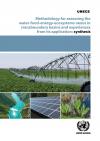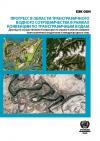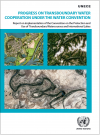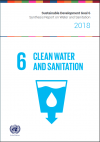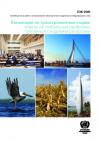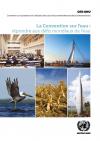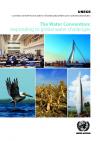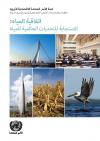Publications
Displaying Results 101 - 120 of 651
- Français
This Synthesis publication covers lessons on interlinkages, trade-offs and benefits in managing water, energy and land/agriculture, as well as on protecting the environment derived from several transboundary river basins in Southern Europe, the Caucasus and Central Asia, and one aquifer system in North Africa. These lessons are the result of the collective experience of Parties to the
- Spanish(西班牙语)
This Synthesis publication covers lessons on interlinkages, trade-offs and benefits in managing water, energy and land/agriculture, as well as on protecting the environment derived from several transboundary river basins in Southern Europe, the Caucasus and Central Asia, and one aquifer system in North Africa. These lessons are the result of the collective experience of Parties to the
- English
This Synthesis publication covers lessons on interlinkages, trade-offs and benefits in managing water, energy and land/agriculture, as well as on protecting the environment derived from several transboundary river basins in Southern Europe, the Caucasus and Central Asia, and one aquifer system in North Africa. These lessons are the result of the collective experience of Parties to the Convention
- العربية
This Synthesis publication covers lessons on interlinkages, trade-offs and benefits in managing water, energy and land/agriculture, as well as on protecting the environment derived from several transboundary river basins in Southern Europe, the Caucasus and Central Asia, and one aquifer system in North Africa. These lessons are the result of the collective experience of Parties to the
ПРОГРЕСС В ОБЛАСТИ ТРАНСГРАНИЧНОГО ВОДНОГО СОТРУДНИЧЕСТВА В РАМКАХ КОНВЕНЦИИ ПО ТРАНСГРАНИЧНЫМ ВОДАМ
- Pусский
In 2015 Parties to the Water Convention decided to introduce a reporting mechanism by which to monitor and assess progress in the implementation of the Convention. A pilot reporting exercise took place in 2017 and 2018, the results of which are presented in this synthesis report. The report closely mirrors the structure of the reporting template. The introduction provides the context to the
- Français
In 2015 Parties to the Water Convention decided to introduce a reporting mechanism by which to monitor and assess progress in the implementation of the Convention. A pilot reporting exercise took place in 2017 and 2018, the results of which are presented in this synthesis report. The report closely mirrors the structure of the reporting template. The introduction provides the context to the
- English
In 2015 Parties to the Water Convention decided to introduce a reporting mechanism by which to monitor and assess progress in the implementation of the Convention. A pilot reporting exercise took place in 2017 and 2018, the results of which are presented in this synthesis report. The report closely mirrors the structure of the reporting template. The introduction provides the context to the
- Pусский
Трансграничные водные ресурсы имеют жизненно важное значение для населения,экосистем и развития бассейнов, однако эти ресурсы подвергаются растущему давлению, что обуславливает важность развития сотрудничества для их эффективного управления. Тем не менее на пути укрепления или налаживания странами эффективного совместного управления трансграничными водами могут возникать многочисленные
- English
Transboundary water resources are vital for populations, ecosystems and for the development of basins, but these resources are under growing pressure, making it crucial to cooperate for their effective management. However, many obstacles exist that can prevent countries from strengthening or embracing the joint management of transboundary waters in an effective way, which in turn can hinder
- Pусский
This policy brief synthesizes the main findings and recommendations from the assessment of the water-food-energy-ecosystems nexus in the Syr Darya River Basin, shared by Kazakhstan, Kyrgyzstan, Tajikistan and Uzbekistan. The methodology employed was developed specifically for assessing the nexus in transboundary basins with multi-disciplinary expertise.
The assessment aimed to foster
- English
Cooperation over transboundary rivers, lakes and aquifers is critical to ensuring that water resources are managed in an equitable and sustainable manner, and the achievement of SDG6 (water). Transboundary waters also create social, economic, environmental and political inter-dependencies that make cooperation a precondition to sustainable development, peace and security. As the only
- English
The Sustainable Development Goal 6 Synthesis Report 2018 on Water and Sanitation builds on the data available for the 11 SDG 6 global indicators. Representing a joint position from the United Nations family, the report offers guidance to understanding global progress on SDG 6 and its
- Pусский
- Français
- Spanish(西班牙语)
- English
- العربية
- Pусский
This publication presents the Principles for Effective Joint Bodies for Transboundary Water Cooperation that were formally adopted by the Meeting of the Parties to the Water Convention at its seventh session (Budapest, 17-19 November 2015). Countries sharing transboundary waters worldwide are encouraged to make use of them when establishing new joint bodies or strengthening existing ones.The
- Français
This publication presents the Principles for Effective Joint Bodies for Transboundary Water Cooperation that were formally adopted by the Meeting of the Parties to the Water Convention at its seventh session (Budapest, 17-19 November 2015). Countries sharing transboundary waters worldwide are encouraged to make use of them when establishing new joint bodies or strengthening existing ones.The
- Spanish(西班牙语)
This publication presents the Principles for Effective Joint Bodies for Transboundary Water Cooperation that were formally adopted by the Meeting of the Parties to the Water Convention at its seventh session (Budapest, 17-19 November 2015). Countries sharing transboundary waters worldwide are encouraged to make use of them when establishing new joint bodies or strengthening existing ones.The


